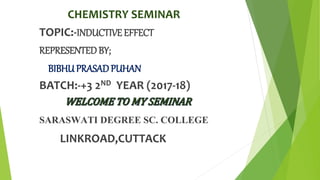
Inductive Effect
- 1. CHEMISTRY SEMINAR TOPIC:-INDUCTIVE EFFECT REPRESENTEDBY; BIBHUPRASADPUHAN BATCH:-+3 2ND YEAR (2017-18) SARASWATI DEGREE SC. COLLEGE LINKROAD,CUTTACK
- 3. 1)INTRODUCTION:- The carbon bond in substrate molecule are broken and to give fragrants are very reactive.At once they react with other species to forms new bond and give the products. There are four types of electron displacement mechanism exhibit in organic molecules. a) Inductive Effect b) Electromeric Effect c) Mesomeric Effect/Resonance Effect d) Hyper Conjugation
- 4. 2)INDUCTIVE EFFECT:- The permanent displacement of shared paired electrons in a carbon chain towards the more electronegative group is known as Inductive Effect. 3)EXPLANATION:- It involves σ electrons.Which forms covalent bond.Different atoms have different electronegative values.That means different power of attracting the electrons in a bond.Electrons are displaced towards more electronegative atom.Which introduced the degree of polarity in the bond.The more electronegative atom get fractional negative charge(δ-)and less electronegative atom get fractional +ve charge(δ+).
- 5. Let’s considering a bond between carbon and other atom ; N Here the carbon hydrogen used as standard that means zero effect is to be Assumed. I n(𝙄𝙄) "X" is more electronegative than;carbon.It acquires some negative charge and “C-atom” acquires some +ve charge and is called “–I”effect.Simillarly in (lll) “C-atom” is more electronegative is called “+I”effect. Hence Inductive effect is classified into two Types; A)-I Effect B)+I Effect
- 6. A Those atoms or groups(X) are called electron withdrawing group or electron attracting group. 1) It deactivates the benzene ring. 2)It is Acidic in nature. 𝒄𝜹𝜹𝜹+ 𝒄𝜹𝜹+ 𝒄𝜹+ 𝑿− EX:-NH3 +,-NO2,SO2,COOH,Cl,Br,I,OC6H5,-CH, -OR,-OH,-C6H5,,-COOR Etc. B)+I Effect:- Those atoms or groups(Y) are called electron donating group.The atom donates electron to the more electron negative atom carbon. a. It activates the benzene ring. b. It is more basic in nature.
- 7. EX:-O-,(CH3)3 C,(CH3)2CH,C2H5,CH2 Etc. In a carbon chain slightly positive charge ”C1”attract the electron being shared between”C1”and“C2”.As a small positive charge is developed on “C2”.The magnitude of this charge will be less than ”C1”.Simillarly the paired electron shared between ”C2” and ”C3” will get displaced in the direction of more electron negative atom. It is almost negligible after three carbon atom. 4)CHRACTERISTICS:- I. It is permanent reversible II. There is no displacement of electron in a C-H group.Bcz Carbon and hydrogen has same electro negative values. III. It involves only in a single bond. IV. It is almost negligible after two carbon atom directly attached to more electronegative group. V. The electron displacement progressively decreases along the carbon atom. C3 𝛅𝛅𝛅- C2 𝛅𝛅- C1 𝛅- Y𝛅+
- 8. 5)APPLICATION:- A)Application-1:- +I explain the polarity of covalent bond in an organic Compound. Inductive explain the relative strength of acid. Inductive also explain the relative strength of base. B)Application-2:- The presence of electron withdrawing group makes acid stronger,Greater the number of “-I” group stronger is the acid. The presence of electron donating group makes the acid weaker.Greater the number of “+I” group weaker is the acid. +I group present in the compound increases the basic character of compound. -I group makes the compound Base weaker.